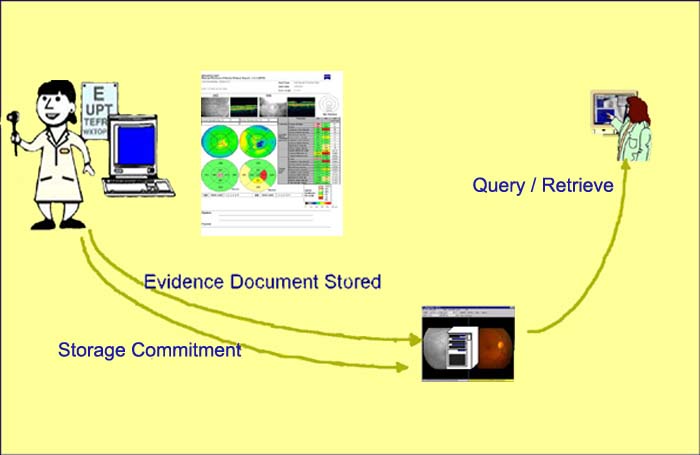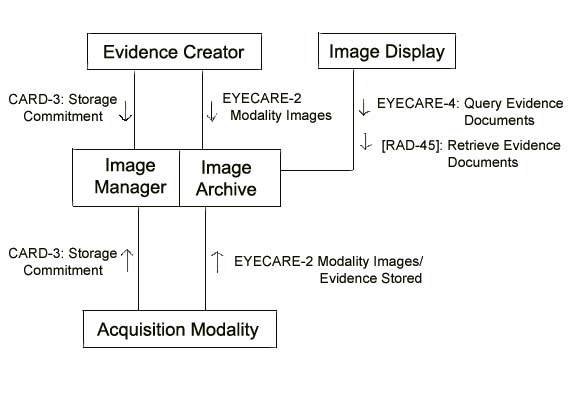Difference between revisions of "Eye Care Evidence Documents"
JohnMoehrke (talk | contribs) |
|||
| (9 intermediate revisions by 4 users not shown) | |||
| Line 1: | Line 1: | ||
| − | + | '''Eye Care Evidence Documents (ECED)''' manages observations, measurements, and peri-procedural results | |
__TOC__ | __TOC__ | ||
| Line 16: | Line 16: | ||
==Details== | ==Details== | ||
| + | |||
| + | The ECED Profile is based the IHE Radiology [[Evidence Documents]] (ED) Profile with further eye care specific options. | ||
A typical use case for evidence documents include them being generated at the Acquisition Modality. A technician performs the acquisition, and the instrument performs implicit post-processing immediately following the acquisition. This may be entirely automatic, or require limited user inputs. An example is glaucoma progression analysis performed on visual field analyzers, or the RNFL analysis performed on an OCT device. The instrument provides the evidence document at the end of the acquisition cycle. | A typical use case for evidence documents include them being generated at the Acquisition Modality. A technician performs the acquisition, and the instrument performs implicit post-processing immediately following the acquisition. This may be entirely automatic, or require limited user inputs. An example is glaucoma progression analysis performed on visual field analyzers, or the RNFL analysis performed on an OCT device. The instrument provides the evidence document at the end of the acquisition cycle. | ||
| Line 29: | Line 31: | ||
*Electronic Medical Record System or Departmental information systems that manage department scheduling | *Electronic Medical Record System or Departmental information systems that manage department scheduling | ||
*Acquisition modalities, e.g., fundus cameras, ultrasound machines, ophthalmic tomography devices, slit-lamp biomicroscopes | *Acquisition modalities, e.g., fundus cameras, ultrasound machines, ophthalmic tomography devices, slit-lamp biomicroscopes | ||
| − | *Image management/archiving (i.e., picture archiving and communication system (PACS)) | + | *Image management/archiving (i.e., picture archiving and communication system (PACS)) |
| + | |||
| + | |||
| + | '''Actors & Transactions:''' | ||
| + | [[Image:Evidence-Doc_system.jpg]] | ||
==Specification== | ==Specification== | ||
| − | '''Profile Status:''' [[Comments| | + | '''Profile Status:''' [[Comments| Final Text]] |
| + | |||
| + | '''Documents:''' [http://www.ihe.net/Technical_Framework/index.cfm#eye| Technical Framework 3.7] | ||
| − | + | :* [http://www.ihe.net/Technical_Framework/upload/ihe_eyecare_tf_rev3-7_vol1_Final_Text_2010-02-15.pdf Vol. 1] | |
| + | :* [http://www.ihe.net/Technical_Framework/upload/ihe_eyecare_tf_rev3-7_vol2_Final_Text_2010-02-15.pdf Vol. 2] | ||
| − | |||
| − | |||
'''Underlying Standards:''' | '''Underlying Standards:''' | ||
:* [http://dicom.nema.org DICOM] | :* [http://dicom.nema.org DICOM] | ||
| − | |||
==See Also== | ==See Also== | ||
http://one.aao.org/CE/PracticeGuidelines/Information_Technology.aspx | http://one.aao.org/CE/PracticeGuidelines/Information_Technology.aspx | ||
| + | [[Category:Profiles]] | ||
| + | [[Category:Eye Profile]] | ||
| + | |||
| + | [[Category:DICOM]] | ||
Latest revision as of 14:48, 4 November 2019
Eye Care Evidence Documents (ECED) manages observations, measurements, and peri-procedural results
Summary
The Evidence Documents Profile defines ways for data recorded in the course of carrying out a procedure step, such as observations, measurements, and results (i.e., evidence documents), to be output by devices, such as acquisition systems and other workstations; to be stored and managed by archival systems; and to be retrieved and presented or used by display and reporting systems.
This allows detailed information, such as reconstructed or derived images, measurements, post processing results, etc. to be made available as input to the process of generating a Clinical Report, either as additional evidence for the reporting physician, or in some cases for selected items in the Evidence Document to be included in the report. A couple of examples include glaucoma progression analysis performed on visual field analyzers, or the retinal nerve fiber layer (RNFL) analysis performed on an ocular coherence tomography (OCT) device.
Benefits
The main benefit is that associated information with an image, such as post-processed data and analysis, can be made available as input for the generation of a physician report.
Details
The ECED Profile is based the IHE Radiology Evidence Documents (ED) Profile with further eye care specific options.
A typical use case for evidence documents include them being generated at the Acquisition Modality. A technician performs the acquisition, and the instrument performs implicit post-processing immediately following the acquisition. This may be entirely automatic, or require limited user inputs. An example is glaucoma progression analysis performed on visual field analyzers, or the RNFL analysis performed on an OCT device. The instrument provides the evidence document at the end of the acquisition cycle.
Eye Care Evidence Documents Being Created by Workstations
This use case describes unscheduled post-processing done after the acquisition has completed. A few examples include a workstation using review software, an EHR system, etc. The post-processing software performs as an image display actor and evidence creator actor. The user is often a doctor. Examples are measurements on fundus images, corneal ablation planning based on corneal topography maps, or measurements on anterior chamber OCT images for phakic IOL implantation planning. The Evidence Creator actor (i.e. post-processing software) may perform queries and retrieves in order to obtain images and other evidence documents. For example, if previous measurements were done, these may be retrieved and used as an input for making more refined measurements. Once the post-processing is completed, the images and/or evidence documents are sent to the Image Archive for storage and the ownership of the objects are handed off to the Image Archive using Storage commitment.
Note: A workstation and/or acquisition modality supporting the Eye Care Evidence Document profile may perform a single query to obtain information about both images and evidence documents (i.e. two queries are not required). Similarly, when retrieving the information, one retrieve could be used to obtain both images and evidence documents.
Systems Affected
- Electronic Medical Record System or Departmental information systems that manage department scheduling
- Acquisition modalities, e.g., fundus cameras, ultrasound machines, ophthalmic tomography devices, slit-lamp biomicroscopes
- Image management/archiving (i.e., picture archiving and communication system (PACS))
Actors & Transactions:
Specification
Profile Status: Final Text
Documents: Technical Framework 3.7
Underlying Standards:
See Also
http://one.aao.org/CE/PracticeGuidelines/Information_Technology.aspx

